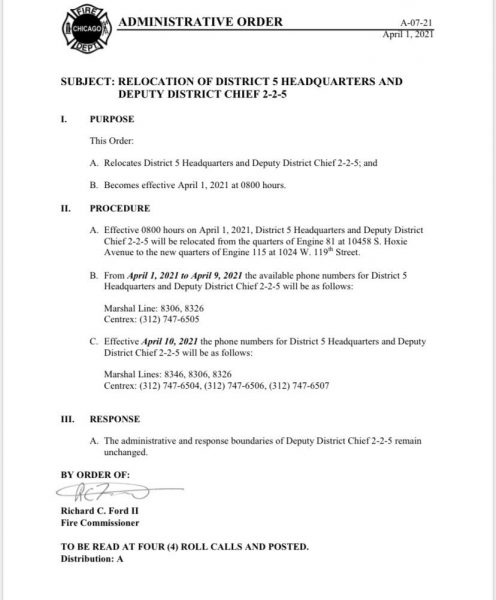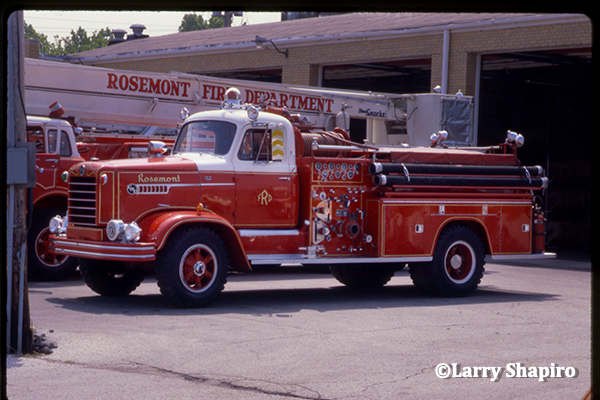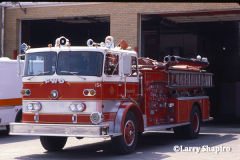Archive for category Fire Department History
Another installment about History of Evanston Fire Department
On Sunday, December 23, 1906, Isaac Terry was killed instantly when an explosion rocked the Northwestern Gas Light & Coke Company works at Clark & Maple after Terry inadvisedly dumped burning ashes into an oil and coal pit. The pit was 45 feet across and 15 feet deep, with 80,000 gallons of oil in the well.
Initial firefighting efforts were hampered when the horses pulling Engine 1’s hose-wagon became frightened and ran away immediately upon arriving at the scene after one of the many explosions thundered from the pit, with the horses and the hose cart eventually ending up at Greenwood Boulevard and the lakefront where the fully loaded hose wagon overturned.
The entire Evanston Fire Department, most of the Wilmette Fire Department — who responded to the blaze aboard their brand new Seagrave combination truck — and two engine companies from the Chicago Fire Department battled the conflagration until 8 PM, with firefighters pouring nearly a million gallons of water onto the inferno. Chicago F. D. Truck Co. 25 changed quarters to Evanston Fire Station # 1 at the height of the blaze.
A couple of months later, on Saturday February 23, 1907, at 2:30 AM, fire destroyed the garage of Edwin F. Brown at Milburn Street & Sheridan Road. The garage was only worth $3,000, but three luxury automobiles — two valued at $5,000 each and one valued at $2,500, — a gasoline engine, a pool table, a sailboat, and miscellaneous tools and furniture were also destroyed, for a total aggregate loss from fire of $20,000, the seventh highest loss from a fire in Evanston’s history up until that point in time.
Two weeks later, Evanston firefighters had to contend with hazardous chemicals caused by spontaneous combustion of phosphorous while battling a blaze at the Northwestern University Science Hall. The next day, the Evanston City Council appropriated funds to purchase a horse-drawn, 85-foot windlass-operated aerial-ladder truck (HDA) with a four-horse hitch from American-LaFrance, something that had been recommended by Chief Carl Harrison just two weeks earlier. Costing $6,700 and financed with a down-payment and three installment payments made each year 1908-10, the truck was placed into service with Truck Co. 1 at Fire Station # 1 after it arrived in July 1907 (and after the west bay of Station # 1 was lengthened to accommodate the new truck).
Because the city council declined to appropriate funds to acquire the four new horses needed to pull the HDA, Hose 2 and Hose 3 were taken out of front-line service and placed into reserve, and the four horses that had been used to pull the two hose carts were reassigned to the new HDA. At this point in time (1907), mostly only large cities had aerial ladder trucks in service, and even then, only half of the Chicago Fire Department’s 32 truck companies operated with aerial-ladder trucks.
To replace the hose carts at Station # 2 and Station # 3, the 1885 Davenport H&L (ex-Truck 1) was transferred from Station # 1 to Station # 3, and hose boxes with capacity for 850 feet of 2-1/2 inch line and a 150-ft lead of 1-1/2 line were installed on both the Seagrave combination truck at Station # 2 and on the Davenport H&L now at Station # 3. Hose Co. 3 was re-designated as Truck Co. 3 at this time, as the EFD now had one engine company and three truck companies in service, with two of the trucks equipped with enough hose to allow the companies at Station # 2 and at Station # 3 to attack fires using direct pressure (plug pressure).
Evanston Fire Department manpower stood at 30 by the summer of 1907, with nine men (the assistant chief, a lieutenant, an engineer, two assistant engineers, and five firemen) assigned to Engine Co. 1, nine men (a captain, a lieutenant, and seven firemen) assigned to Truck Co. 1, six men (a captain, a lieutenant, and four firemen) assigned to Truck Co. 2, three men (a captain and two firemen) assigned to Truck Co. 3, two chief’s buggy drivers (one primary and one relief), and the chief, with the 29 line firefighters working a 112-hour work week (24 hours on / 12 hours off, with meal breaks taken away from the firehouse, either at home or in a nearby restaurant). So 19 or 20 men were usually on duty at any one time, although men were coming & going constantly.
The aerial ladder wasn’t needed very often, but on July 4, 1908, Truck 1’s stick was extended to the roof of the First Congregational Church at Lake & Hinman to help suppress a blaze caused by errant fireworks. Chief Harrison ordered soda-acid chemicals from the Babcock chemical engine and from the Seagrave combination truck to be used to extinguish the blaze, rather than water supplied from the ALF Metropolitan steamer or from direct plug pressure, so as to minimize water damage to the sanctuary.
The summer of 1908 was unusually hot and dry, and the EFD responded to a record 28 calls over the first five days of August. Firefighters were going out constantly, and on August 5th three alarms were received within a five-minute period, the most serious being a blaze that heavily damaged the C&NW RR platform at Davis Street. Five days later, Evanston firefighters saved the Weise Brothers planing mill and lumber yard on Dodge Avenue after a large prairie fire communicated to a pile of lumber.
In January 1909, the Evanston City Council approved a pay raise for 27 of the 30 members of the Evanston Fire Department, including a $10 per month increase for the chief, a $5 per month increase for the assistant chief, and a $2.50 per month increase for all other members of the department except for the engineer and the two assistant engineers.
This from Mike Summa for #TBT:
For TBT- Oak Brook Fire Dept. #916. Photo taken at a fire muster in Downers Grove in the early 1990’s. And that is all I know. If anyone can fill in the blanks, please do so.Mike Summa

Mike Summa photo
And from our archives

Custom Pirsch engine with 50′ Boardman Readi-Tower aerial. Larry Shapiro photo
Another installment about History of Evanston Fire Department
In March 1906, the Evanston Fire Department took delivery of a new American LaFrance “Metropolitan” 700-GPM second-size steam fire engine with a three-horse hitch. It was the first apparatus acquired by the EFD that required more than two horses to pull it, and it cost $5,500, plus $250 for a new horse that was added to the two already assigned to Engine 1. The new Metropolitan steamer was heavier and more-powerful than the Ahrens Metropolitan 600-GPM second-size steamer with a two-horse hitch that had been in service with the EFD since 1895.
The plan was for the older Ahrens Metropolitan steamer to be sent to the American LaFrance factory in Elmira, NY, for a complete overhaul, after-which it would be returned to Evanston and placed into service at Station # 2. However, the Evanston City Council declined to appropriate funds to purchase two additional horses and hire additional manpower that would be needed in order to place the second steamer into front-line service, so while the older steamer was indeed moved into Station # 2 after it came back from Elmira, it was kept in reserve status for several years until such time as more horses could be purchased and additional manpower could be hired.
The Metropolitan was the most-popular steam fire engine of the day, and while Evanston’s new Metropolitan steamer was built by American-LaFrance, the EFD’s older Metropolitan steamer was built by the Ahrens Manufacturing Company of Cincinnati, OH. The Metropolitan was invented in the 1890’s by Chris Ahrens, founder of the Ahrens Manufacturing Company, and along with Button, Clapp & Jones, and Silsby, Ahrens was one of four steam fire engine companies that merged to form the American Fire Engine Company (AFEC) in 1891. This was the era of monopolies and trusts, and the purpose of establishing AFEC was to reduce or maybe even eventually eliminate competition, consolidate the sales force, and maximize profits. Although each of the four companies maintained their own separate corporate identity, AFEC production facilities were located at the Ahrens Manufacturing Company plant in Cincinnati and at the Silsby Manufacturing Company plant in Seneca Falls, NY. However, because the other two major steam fire engine manufacturers of the day — Amoskeag and LaFrance — did not participate in the merger, the overall benefit of the AFEC consolidation was minimal.
While there were four steam fire engine manufactures under the AFEC umbrella, Ahrens was by far the biggest and most-successful. Ahrens built its Metropolitan steamer in various sizes, and it was sold to fire departments — including the Evanston F. D. — across the country throughout the 1890s. Ahrens also manufactured the radical / eccentric, overly-heavy, and not very successful “Columbian,” which was built for and displayed at the World’s Columbian Exposition at Jackson Park in Chicago in 1893. The Columbian featured both a standard steam engine AND a hose supply-bed on the same rig. The common practice at the time the Columbian was being introduced and marketed was for an engine company to operate with a steam fire engine and a hose cart running as separate rigs, and unfortunately for Ahrens, most fire chiefs at that time just could not see the advantage of combining the two functions in one apparatus.
While the American Fire Engine Company was attempting to establish itself as the “big dog” in the world of steam fire engines, the LaFrance Fire Engine Company was busy acquiring patents for both the Hayes and the Babcock aerial-ladders, the two most popular aerial-ladder designs of the 19th century, effectively giving LaFrance control over the manufacture of all aerial-ladder trucks built in the U. S. It was not until 1900 — when the American Fire Engine Company merged with LaFrance, Amoskeag, and a number of other manufacturers of firefighting equipment and apparatus such as the Rumsey Company, Gleason & Bailey, the Charles T. Holloway Company, and the Macomber Fire Extinguisher Company to form the International Fire Engine Company, that the trust was fully established.
The International Fire Engine Company name was changed to American-LaFrance Fire Engine Company as all production moved to the LaFrance plant in Elmira, NY, in 1904, but just as with AFEC ten years earlier, post-merger profits were not as great as had been anticipated, in part thanks to a new kid on the block.
The Seagrave Corporation was located in Columbus, OH, and while Seagrave did not build steam fire engines, it did manufacture first-rate horse-drawn chemical engines and hook & ladder trucks, as well as the very popular “combination truck,” so-called because it combined a chemical engine and a hook & ladder truck in one apparatus. Seagrave combination trucks were in service with fire departments across the U. S., and then beginning in 1900, Seagrave started manufacturing horse-dawn aerial-ladder trucks that competed successfully with the American-LaFrance aerial-ladder truck.
Meanwhile, tired of living the life of a retired independently wealthy squire, Chris Ahrens rediscovered his latent entrepreneurial spirit and sold his share in American-LaFrance in 1904. Together with sons John and Fred and son-in-law and Cincinnati Fire Chief Charles H. Fox, formed a new company called the Ahrens Fire Engine Company at the old Ahrens Manufacturing Company plant in Cincinnati. The company’s name was changed to the Ahrens-Fox Fire Engine Company in 1908 when Charles Fox became company president, and it quickly became the # 2 steam fire engine manufacturer and American-LaFrance’s chief competitor in the area of steam fire engines. But it wasn’t easy.
Because American-LaFrance retained all patents held by the various companies that formed ALF — including the Metropolitan patent originally filed by Chris Ahrens in the 1890s — Ahrens-Fox could not build the Metropolitan. And so instead, Chris Ahrens invented, developed, and built a completely new steam fire engine called the “Continental” that did not infringe on any existing patents, and in fact the Ahrens-Fox Continental sold very well, and might even have eventually matched or even exceeded American-LaFrance’s Metropolitan in sales, except the steam fire engine era came to a rather abrupt end in 1915.
From Dennis Maag:
St. Marys, KS – Ladder 371991 Emergency One Hush #8893 1000-GPM (American)/500/75′6V92/Allison AutomaticEx-Buffalo Grove, IL5-15-13
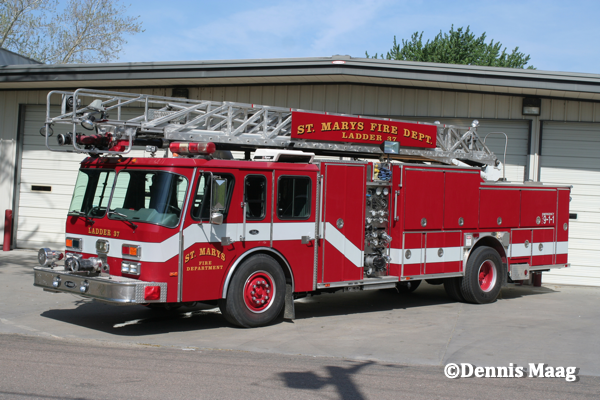
Dennis Maag photo
And from our archives:
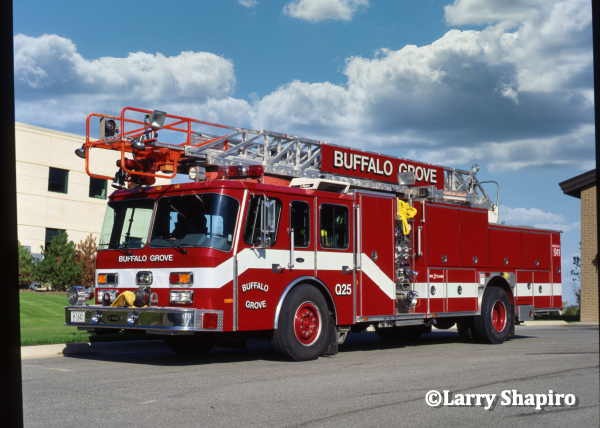
Larry Shapiro photo
This from Mike Summa for #TBT:
For TBT- Munster, Indiana Engine 3, a 1987 Mack/Boyer 1500/750.Mike Summa

Mike Summa photo
Another installment about History of Evanston Fire Department
The Aftermath:
“It was said of George Stiles… as a fireman, none better… that he was one of the most-popular men in the Department… that he had a kind word for everyone…. so shall we not then cherish his memory, and think of these splendid men more highly than ever before?”
— Dr. Wilkinson, Pastor of Wheadon Methodist Church, speaking at the George Stiles funeral, December 14, 1905
At 9 AM on December 14, 1905, the day after the Mark fire, an Evanston Fire Department honor guard — Lt. John Watson, and firemen Henry Newton, Harry Schaeffer, and Walter Hubert — escorted the earthly remains of Fireman William Craig from his residence at 1924 Jackson Avenue to the Davis Street C&NW RR depot. A “fire helmet” of fresh cut flowers with Craig’s badge number “123” worked into the center of the arrangement was displayed atop the Engine 1 hose wagon that carried Craig’s casket. EFD Assistant Chief Jack Sweeting accompanied the Craig family to Knoxville, Illinois, where the deceased firefighter was laid to rest.
At 2 PM on the same day, Evanston firefighters and town residents attended the funeral for Fireman George Stiles at Wheadon Methodist Church on Ridge Avenue. Dr. Wilkinson officiated. Pallbearers were Capt. George Hargreaves, Lt. Thomas Norman, Engineer J. A. Patrick, and firemen William Sumpter, John Eckberg, and John Reddick. Among those present at the service was former EFD Chief Norman Holmes. After the service, the Evanston Fire Department honor guard led the funeral procession (with the casket of deceased fireman Stiles aboard the same hose wagon used to transport William Craig’s casket to the C&NW RR dept earlier in the day) down Ridge Avenue to Rosehill Cemetery in Chicago, where the fireman was laid to rest.
The next day (Friday December 15, 1905), with Stiles and Craig dead, firemen Ed Johnson and Thomas Watson still in the hospital, and Assistant Chief Sweeting in Knoxville, the undermanned Evanston Fire Department led by new EFD Chief Carl Harrison had a tough time battling a large fire at Lyons Hall at 621 Davis Street. Before it could be contained, the blaze caused heavy damage to the third floor and rear of the venerable structure, as well as significant smoke and water damage to the rest of the building.
Built in 1868, Lyons Hall had served as a popular spot for political meetings, wedding receptions, dances and proms, and other events for almost 40 years. The first meeting of the aboriginal Pioneer Fire Company of Evanston took place at Lyons Hall in January 1873. The aggregate damage to the building was $12,000, including $8,000 to the structure itself, and an additional $4,000 in damage to a photographer’s studio, tailor shop, shoe store, fruit shop, and real estate office on the first floor, and to apartments on the third floor.
In January 1906, Lt. Thomas Norman was promoted to Captain and replaced new EFD Chief Carl Harrison as company officer of Hose Co. 3, and Fireman William Sumpter was promoted to Lieutenant and was assigned as assistant company officer of Engine Co. 1. George Stiles was next on the promotional list for lieutenant, and so he would have been the new lieutenant if he hadn’t been killed in the Mark fire.
Also in January 1906, the Evanston City Council approved a pay raise for all members of the Evanston Fire Department, except the chief. Included in the package was a $5 per month increase for the assistant chief fire marshal and the three captains, and a $2.50 per month increase for all other members.
After becoming chief, Carl Harrison instituted wide-ranging training lectures for Evanston firefighters. Among the speakers were an architect and an electrical engineer. Harrison also proposed using rocket flares and balloons to facilitate communication between firefighters on the scene of an alarm and others still en route. In the days before radio communication, fire companies responding to an alarm could not be contacted prior to arriving at the scene, and then firefighters would have to hurry back to the firehouse in case an additional alarm was received while they were on the road. Although it might have sounded like a good idea at the time, Chief Harrison’s communication plan involving rocket flares and balloons was not implemented.
Another installment about History of Evanston Fire Department
Harrison accepted the appointment, but because he did not wish to begin his tenure as Fire Marshal on the “unlucky 13th,” he requested that he not assume his new post until Thursday, December 14th. Thus, Assistant Chief Jack Sweeting would be acting chief for one more day. Little did anyone know that it was to be the darkest day in the history of the Evanston Fire Department.
Located at 1900 Dempster Street, the Mark Manufacturing Company was Evanston’s largest employer in 1905, with a work-force of 1,000. Established in 1901 by Cyrus Mark and his sons, Clayton and Anson, the company — a subsidiary of the Youngstown Steel & Tube Company — manufactured wrought-iron pipe. The company’s plant actually consisted of several different buildings, including the pipe mill, the engine house, a warehouse, and several smaller buildings and sheds.
At 12:50 PM on Wednesday, December 13, 1905, the Evanston Fire Department was notified of a fire at the Mark Manufacturing Company plant. Crude oil leaking from a pipe in the mill’s socket room had ignited, and the 200 employees in the building were safely evacuated. Mark employees battled the blaze with the company’s own fire fighting equipment while the EFD was en route.
Upon arrival at about 1 PM, firemen from Station # 1 encountered heavy fire inside the pipe mill. Because the plant was located on the outskirts of town, water-pressure was low, and direct-pressure from hydrants was not effective. The fire was much too large for the chemical-engine to be useful, and the fire department’s lone steam fire engine — the 600 GPM ”City of Evanston No. 1” — could supply only two, 2-1/2” hose-lines.
With few options available, Assistant Chief Sweeting ordered Truck Co. 1 to make entry and attack the fire through the front door on the north side of the building, and Engine Co. 1 to play a second stream through a door at the southeast corner of the building, from a position in the alley between the plant’s pipe mill and engine house.
Although firemen from Truck Co. 1, led by Lt. Thomas Norman on the north side of the pipe mill were driven-back while attempting to make entry, Fireman Thomas Watson was overcome by smoke and gas and had to be rescued by other fire fighters. The crew at the southeast corner of the building (Engine Co. 1, led by acting assistant company officer George Stiles) was able to direct its stream through an open doorway onto the seat of the fire.
At about 1:15 PM, Stiles told one of his men — rookie firefighter George McKimmons — that the hose-lead was too short, and that he should go out front and pull up the slack. With McKimmons 30 feet away at the north end of the alley, and with Engine Co. 1 pipemen Stiles, Edward Johnson, and William Craig playing their stream through the southeast door of the pipe mill from a location inside of a storage shed adjacent to the alley, an explosion from the interior of the pipe mill caused the south wall to totter. Seeing that the wall was unstable, Stiles yelled for the crew to evacuate.
As Stiles, Craig, and Johnson came around the corner of the alley, a second more-powerful explosion occurred, and the east wall collapsed onto them. Craig, in front of the other two, was buried under the collapsed wall. Johnson, in the middle, was struck by falling debris, but was not buried. Stiles, at the rear of the column, was buried under burning debris.
George McKimmons called to the other firemen working in front, and Assistant Chief Sweeting and Truck Co. 1 (Lt. Norman and firefighters Jack Eckberg, Walter Hubert, William Ludwig, and Joseph Steigelman), along with Engine Co. 1 teamster George Gushwa, hurried to the rubble with the other hose line. As their fellow firemen poured water onto them to protect them from the intense heat, Eckberg and McKimmons were able to extricate Craig within five minutes. He was pulled out — alive, but disoriented — and reportedly asked McKimmons, “Where are we going?”
Evanston Police officers W. J. Schultz and John Keane transported Craig to St. Francis Hospital in the police ambulance. While en route, Craig was asked if he was hurt, to which he supposedly replied, “Not much.” However, Craig died shortly after arrival at the hospital.
After rescuing Craig, firemen spent another few minutes extricating Stiles. He was located lying face-down with two large pulley-wheels around his neck, unconscious from a severe head injury. Stiles was transported by other firefighters aboard Engine Co. 1’s hose wagon to St. Francis Hospital, where he was pronounced dead on arrival.
William Craig, a native of Knoxville, Illinois, was 35 years of age, and had just returned to the Evanston Fire Department the previous summer after spending four years as a dining car conductor on the Illinois Central Railroad. He had originally joined the EFD on January 31, 1901, but left after less than a year. Craig was survived by his wife, child, mother, father, and sister.
George Stiles was 32 years old, and had served nearly five years with the EFD. Like William Craig, Stiles also joined the fire department on January 31, 1901. He was to have been promoted to lieutenant in January 1906. He was survived by his wife of 11 years (Caroline), a nine-year old daughter (Stella), a seven-year old son (Howard), his mother, and a sister.
In addition to the deaths of William Craig and George Stiles, three other Evanston firemen were seriously injured; Thomas Watson suffered burns, bruises, and smoke and gas inhalation, and was reported “critical and near death” upon arrival at St. Francis Hospital; Edward Johnson sustained lacerations to the back of his head and severe bruises to his hands and knees when struck by the wall; and Jack Eckberg suffered burns and bruises while working to extricate Craig and Stiles. Another fireman — Joseph Steigelman — was spared serious injury when he was struck on the helmet by a falling brick.
With two firemen dead and three others injured, firefighting efforts were furthered hampered by freezing temperatures, high winds, and a damaged valve on the steam fire engine. The Chicago Fire Department was summoned, and eventually extinguished what was left of the blaze amidst the rubble and ruins. Superstitious Carl Harrison (The Man Who Would be Fire Marshal) arrived sometime after the wall collapsed, maintaining he was only there as a spectator.
The Mark Manufacturing Company sustained $115,000 damage; the pipe mill was destroyed, the engine house was severely damaged, much machinery and stock were lost, and several freight cars located on a railroad siding on the west-side of the plant were heavily-damaged or destroyed. The $115,000 loss was the highest amount recorded in an Evanston fire until Boltwood Intermediate School was destroyed by fire ($308,500 loss) on January 9, 1927. And no more Evanston firefighters were killed in action for almost 80 years — until the afternoon of July 22, 1985, when Marty Leoni died after he was trapped on the second floor of a residence following an apparent backdraft explosion at a house fire at 1927 Jackson Ave.
George McKimmons, the rookie fireman whose first day on the job was December 13, 1905, served two tours of duty with the Evanston Fire Department, eventually leaving for good in 1915 to join the Chicago Fire Department. After being promoted to the rank of Captain, McKimmons organized CFD Truck Co. 44 at Engine Co. 55’s house at Sheffield & Diversey in 1928. His brother Dan was an Evanston fireman for 31 years, retiring as a lieutenant in 1943.
Another installment about History of Evanston Fire Department
By the Summer of 1903, Evanston’s population stood at 21,621, not including the turkeys Capt. Carl Harrison was raising in the basement of Fire Station #3.
Meanwhile, two fires within four days of each other in March 1904 resulted in close calls for three Evanston firefighters. In the early morning hours of March 10 Capt Jack Sweeting was overcome by smoke while battling a blaze at the Blanchard flats at Grove & Oak, and wass rescued by Capt. Carl Harms and fireman William Pruter. Then a few minutes later, Harms suffered broken ribs when he fell through the floorboards and landed in the basement. Four days later, “blind pig” proprietor Mary Kelly and her daughter jumped out of a second floor window and into the arms of a passing citizen as fire swept through her residence (tavern) at 503 Chicago Ave. Rookie fireman William Ludwig was found unconscious inside the tavern, before being pulled to safety by other firefighters. All injured men recovered and returned to duty.
Two months later, a late night fire swept through the B. B. Noyes coal & feed store at 1003 Church Street. The fire had to be attacked from the exterior using multiple hose lines — including three lines supplying water to the new Eastman Deluger — because of the fear that coal and grain dust might explode. While firefighters were able to eventually contain the blaze to the structure of origin, water pressure was increased in mains to more than two times normal residential pressure, causing damage to plumbing in some Evanston residences.
The city council received complaints from several prominent Evanston residents who criticized the fire department’s tactics (use of direct plug pressure), but Chief Mersch explained that unless and until additional steam fire engines were acquired and placed into service, the use of plug pressure and increasing pressure in water mains to fight fires must continue.
Chicago Fire Department Captain Norman Holmes (company officer of CFD Truck Co. 20) replaced Ed Mersch as chief of the Evanston Fire Department in May 1905, after Mersch was fired by Mayor John Barker. Holmes served as chief of the EFD for only seven months, however, before taking a job in the private sector as Fire Marshal of Sears, Roebuck & Company. Chief Holmes’ tenure with the Evanston Fire Department was marked by controversy, and his leaving so soon after his appointment probably had as much to do with the hostile reception he received in Evanston as it had to do with an opportunity to work for Sears.
The problem Holmes had as chief had nothing to do with his competence. Rather, South Evanston residents saw former Chief Ed Mersch as one of their own, and felt that he had been fired for purely political reasons (which was probably true). Though it was Mayor Barker who had sacked Mersch, the residents of South Evanston directed their anger and resentment toward Holmes, making life very difficult for the new chief. Soon after his arrival, a group of South Evanstonians initiated legal action to have the appointment overturned, on the grounds that Holmes had not been an Evanston resident for one year before the appointment.
This issue was resolved when it was decided by a court that the one-year residency rule only applied to individuals running for political office, and not to political appointees. But even with the court ruling in his favor, Holmes had had enough of Evanston politics. Meanwhile, another member of the EFD left for greener pastures, as veteran fireman (and chief’s buggy-driver & secretary) Edwin Whitcomb was appointed chief of the Kewanee Fire Department in October 1905.
One notable improvement implemented by Holmes before he resigned was the introduction of 1-1/2 inch hose lines and smaller nozzles, which were used extensively by the Chicago Fire Department when he was a company officer there. The smaller-diameter hand lines were easier to carry and would help reduce water damage to property when fighting smaller interior fires.
Holmes also lobbied for the establishment of the new civil service rank of Assistant Chief Fire Marshal, whose duties would include company officer of Engine Co. 1 as well as acting chief if the Fire Marshal was absent from the city or otherwise unavailable. Capt. Jack Sweeting was promoted to the new rank of assistant chief in July 1905.
On December 13, 1905, two Evanston firemen were killed while battling a fire at the Mark Manufacturing Company plant at 1900 Dempster St. Then a little over a year later, on Sunday, December 23, 1906, a workman was killed in an explosion at the Northwestern Gas Light & Coke Company (“gasworks”) at Clark & Maple. The man (Isaac Terry) made the fatal mistake of dumping burning ashes into a tar and coal pit. The fire that followed the explosion required eight hours and nearly a million gallons of water to extinguish, as the EFD was assisted by the Wilmette Fire Department (responding aboard their brand-new horse-drawn Seagrave “combination truck”) and two Chicago engine companies.
